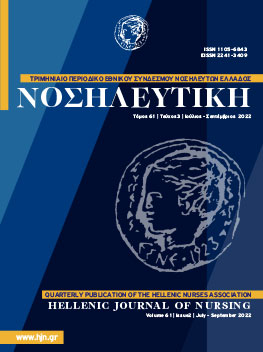Disaster Preparedness among Physicians and Nurses: Inferential Statistical Analysis of 2010 Decade Data
Introduction: In the decades 1990 and 2000, more than three million deaths of people have occurred worldwide because of disasters. Considering the ongoing increase of various threats, the likelihood of happening disastrous events is constantly increasing. Today’s societies are depended on the hospitals and require from them to be able to respond efficiently and effectively to a potential crisis.
Aim: The aim of this study was the exploration of physicians’and nurses’disaster preparedness inferentially analyzing 2010 decade data.
Material and Method: A cross-sectional research was conducted from February 2012 to April 2013. Three hundred and sixty-four physicians and nurses participated. A disaster preparedness questionnaire was used. Univariate and multivariate logistic regression analysis for the sociodemographic characteristics’ parameters and their relation to the dependent variable of disaster preparedness perception were performed.
Results: Sixty one percent of the responders perceived themselves as “To- tally unprepared” and “Somewhat unprepared” for disasters. The univariate logistic regression analysis was significant (P≤0.05) for the married status (reference category: single) (OR 1.87, 95% CI 1.20–2.93, P=0.006), for the having children status (reference category: no) (OR 1.64, 95% CI 1.05–2.54, P=0.029), the “11–15” years of work experience (reference category: “1–5” years of work experience) (OR 2.81, 95% CI 1.14–6.92, P=0.025), the having postgraduate degree status (reference category: undergraduate degree) (OR 1.64, 95% CI 1.01–2.65, P=0.044), the being a nurse status (reference category: physician) (OR 2.12, 95% CI 1.15–3.92, P=0.016), the “Attendance of Disaster Nursing/Medicine program/course” status (reference category: interested to attend) (OR 8.42, 95% CI 3.04–23.38, P<0.001) and for the participation in any disaster management activity at workplace status (reference category: no) (OR 3.33, 95% CI 1.70–6.50, P<0.001). In relation to the sociodemographic characteristics’ multivariate logistic regression analysis, only the “Attendance of Disaster Nursing/Medicine program/course” status was significant (OR 16.71, 95% CI 3.36–83.06, P=0.001). Conclusions In the present research, it was detected that a high percentage of the Greek physicians and nurses (61.0%) perceived their self as unprepared for disasters. Moreover, in the current study, it was found that the Disaster Nursing/Medi- cine program/course attendance is a strong positive determining factor of disaster preparedness perception. For enhancing physicians’ and nurses’ disaster preparedness, attention to its pre-service and in-service education should be given, by providing evidence-based disaster preparedness educational interventions. Additionally, the disaster preparedness education research should be continued for yielding even more effective relevant educational interventions than the current ones.
| Κατηγορία: | Volume 61, Issue 1 |
| Hits: | 28220 Hits |
| Ημ/νία Δημιουργίας: | 10-10-2022 |
| Συγγραφείς: | Aristomenis Kossioris , Efstratios Kossioris , Dimitrios Koukoularis , Charalampia Petropoulou , Eleni Kyritsi , Ioannis Koutelekos |
 Ελληνικά
Ελληνικά  English
English 

